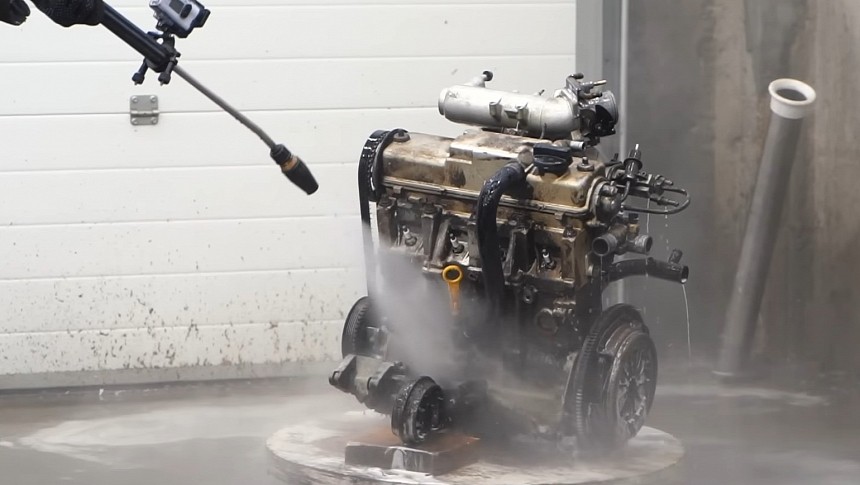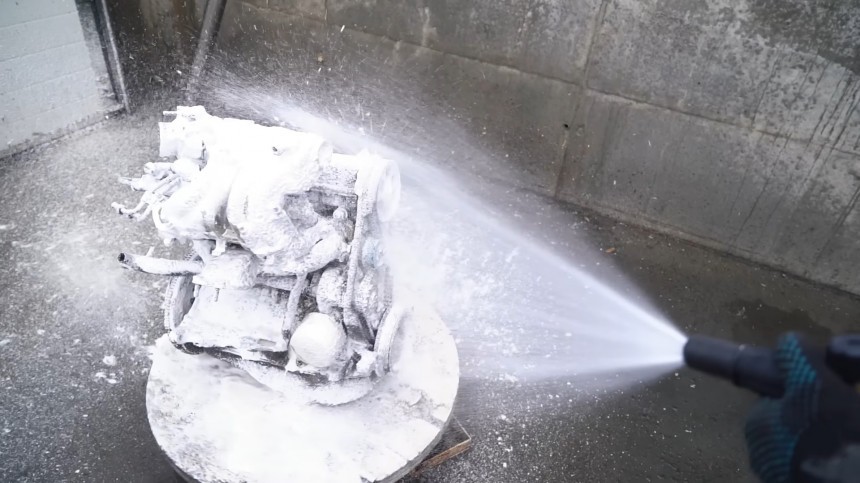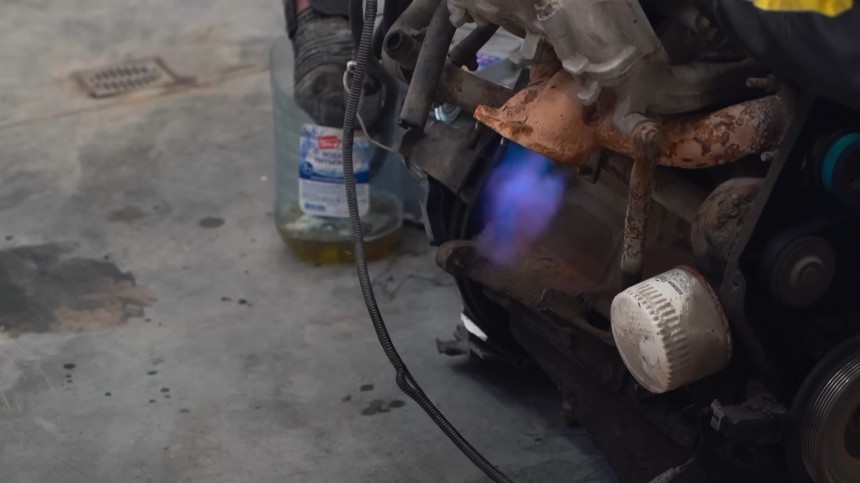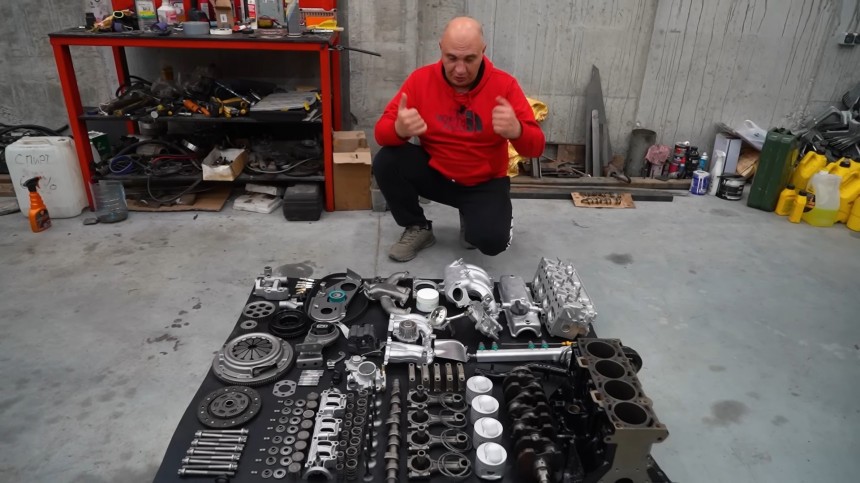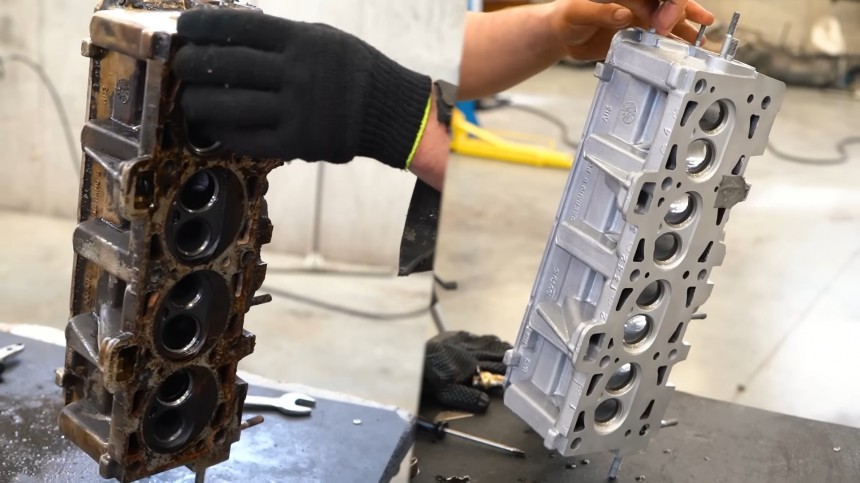Fire and water don’t generally go along– each tends to make the other disappear. The story has been unfolding since the literal beginning of time, exactly when the Big Bang occurred, and these two elements of creation said to each other, “I can’t live with you around.”
That’s why it’s wise not to expose a combustion engine to water. Water-based coolant prevents the assembly from overheating, but the fire inside the cylinders and the water surrounding them don’t mix. However, there is an amendment to this rule, and it comes from (where else if not) Russia.
The happy mechanics from Garage 54 got their hands on a filthy inline-four fuel injected “Made In Russia” automobile engine and pressure washed the death out of it. Not before testing it to demonstrate how it runs and doing a compression test. Suffice it to say that the miserable powerplant had a neglected existence.
The internet is filled with videos showing how maltreated engines look and behave if the car’s owner doesn’t perform regular maintenance correctly. I am referring to the good old common-sense oil change done in time. Well, the Russian four-pot guinea pig didn’t have that luck.
Let’s put it like this: a cast iron skillet that came out of the foundry in 1882 and has seen six generations’ worth of seasoning would be the closest yardstick to explain how thermal breakdown ruins the motor. If the oil in a combustion engine is not changed in time, it loses its viscosity and gradually turns into a gel – think marmalade consistency.
Engine oil is a hydrocarbon, basically, and exposing it to high temperatures creates various carbon compounds, some of which are solid. Slowly but dreadfully, carbon residues start adhering to metal, obstructing oil passages, and leading to severe metal fatigue of the moving parts (pistons, cylinder walls, crankshaft, bearings, mains, cams, valves, the lot). Better yet, play the video and see how the oil change neglect is the motoring equivalent of first-degree murder.
Besides the chemical breakdown of oil molecules and the corresponding transformation of the lubricant into a high-friction sludge, the debris buildup in the engine will burn – hence the colorful clouds of asphyxiating smoke coming out of the exhaust galleries.
This is where the Russian water experiment comes into play. The wrench-wielding Siberians from Novosibirsk have taken the battered car engine apart and then pressure-washed it. The process is called water blasting and, as the name implies, is similar to sandblasting. A high-pressure water jet is applied instead of using a particulate medium to remove surface deposits from the engine components.
The results are probably better since water only removes dirt, leaving the surface intact (granted, the pressure of the jet isn’t high enough to affect the structure of the metal). The downside of water blasting (as opposed to media blasting) is the longer time required to do the job.
But this is a scientific experiment, and time is a resource worth spending for the sake of motoring progress. After each and every single component has been cleaned to “beyond-brand-new” status, the engine is put back together and tested again. Of course, several parts have been replaced after being deemed unusable (gaskets, seals, belts, and other accessories).
Once again, nothing of the engine’s internal or critical components has been serviced, rebuilt, repaired, or adjusted in any way – not even the piston rings. It’s a “simple” deep cleaning operation – a complete engine detailing if you will, and the results are hat-tipping incredible.
Before the cleansing treatment, the poor engine was the piston equivalent of scab and tuberculosis put together, coughing smoke like a steam locomotive and barely hitting 115 PSI of compression (8 kg per square centimeter). The compression rings were completely seized in their grooves, covered in thick, sticky sludge.
After the high-pressure shower (and an extra foam enema for the oil galleries to evict the stubborn gunk), the sparkling engine runs as smooth as Milky Way milk. No smoke whatsoever and a sturdy compression of 160 PSI (11 kg / sqcm) – the factory-specified ratings – all thanks to little more than a water spray rejuvenation.
The engine was correctly lubricated, coolant was poured into its respective passages, and the valves were ground and adjusted. But the seals and gaskets were a $30-budget investment, so it’s a fair trade, to say the least.
Also, please observe that all the components have been thoroughly dried before the assembly was put back together, so don’t just throw that big-block in the dishwasher (give it a tumble dry afterward. No, I’m joking, don’t do that to it. Try squeezing it out and hanging it out to dry.)
In all fairness, the mechanics didn’t reveal the manhours for this experiment. I’ll assume every gearhead with a decent amount of consideration toward their engine is willing to do the same to their trusty powerplant to get these kinds of results.
Sure, the Russians from Novosibirsk didn’t do a full video documentary on the engine teardown, cleaning, and rebuilding. Still, it’s pretty self-explanatory that the engine was adequately tuned after its water-infused resurrection. So, the next time the old motor starts sounding like an old dog catching its breath, give it a good water-blasting. It might be good for another hundred thousand miles or so…
The happy mechanics from Garage 54 got their hands on a filthy inline-four fuel injected “Made In Russia” automobile engine and pressure washed the death out of it. Not before testing it to demonstrate how it runs and doing a compression test. Suffice it to say that the miserable powerplant had a neglected existence.
The internet is filled with videos showing how maltreated engines look and behave if the car’s owner doesn’t perform regular maintenance correctly. I am referring to the good old common-sense oil change done in time. Well, the Russian four-pot guinea pig didn’t have that luck.
Engine oil is a hydrocarbon, basically, and exposing it to high temperatures creates various carbon compounds, some of which are solid. Slowly but dreadfully, carbon residues start adhering to metal, obstructing oil passages, and leading to severe metal fatigue of the moving parts (pistons, cylinder walls, crankshaft, bearings, mains, cams, valves, the lot). Better yet, play the video and see how the oil change neglect is the motoring equivalent of first-degree murder.
Besides the chemical breakdown of oil molecules and the corresponding transformation of the lubricant into a high-friction sludge, the debris buildup in the engine will burn – hence the colorful clouds of asphyxiating smoke coming out of the exhaust galleries.
The results are probably better since water only removes dirt, leaving the surface intact (granted, the pressure of the jet isn’t high enough to affect the structure of the metal). The downside of water blasting (as opposed to media blasting) is the longer time required to do the job.
But this is a scientific experiment, and time is a resource worth spending for the sake of motoring progress. After each and every single component has been cleaned to “beyond-brand-new” status, the engine is put back together and tested again. Of course, several parts have been replaced after being deemed unusable (gaskets, seals, belts, and other accessories).
Before the cleansing treatment, the poor engine was the piston equivalent of scab and tuberculosis put together, coughing smoke like a steam locomotive and barely hitting 115 PSI of compression (8 kg per square centimeter). The compression rings were completely seized in their grooves, covered in thick, sticky sludge.
After the high-pressure shower (and an extra foam enema for the oil galleries to evict the stubborn gunk), the sparkling engine runs as smooth as Milky Way milk. No smoke whatsoever and a sturdy compression of 160 PSI (11 kg / sqcm) – the factory-specified ratings – all thanks to little more than a water spray rejuvenation.
Also, please observe that all the components have been thoroughly dried before the assembly was put back together, so don’t just throw that big-block in the dishwasher (give it a tumble dry afterward. No, I’m joking, don’t do that to it. Try squeezing it out and hanging it out to dry.)
In all fairness, the mechanics didn’t reveal the manhours for this experiment. I’ll assume every gearhead with a decent amount of consideration toward their engine is willing to do the same to their trusty powerplant to get these kinds of results.
Sure, the Russians from Novosibirsk didn’t do a full video documentary on the engine teardown, cleaning, and rebuilding. Still, it’s pretty self-explanatory that the engine was adequately tuned after its water-infused resurrection. So, the next time the old motor starts sounding like an old dog catching its breath, give it a good water-blasting. It might be good for another hundred thousand miles or so…
